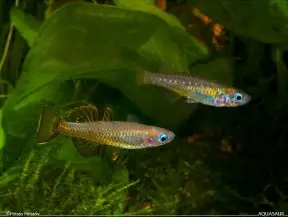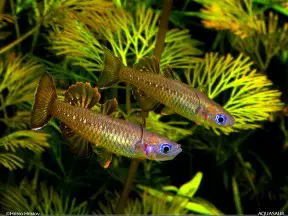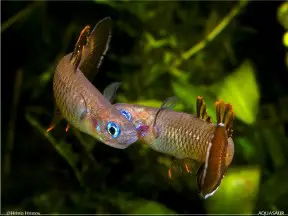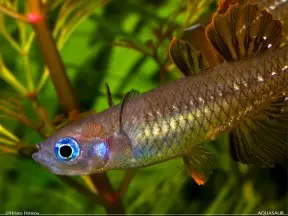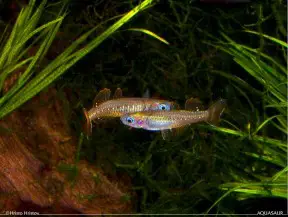Pseudomugil tenellus
Delicate Blue-eye
Etymology
Pseudomugil: from the Ancient Greek ψευδής (pseudes), meaning ‘false, lying, untrue’, used here as a prefix, and the generic name Mugil.
tenellus: from the Latin tener, meaning ‘soft, tender’.
Classification
Order: Atheriniformes Family: Pseudomugilidae
Distribution
Described from ‘Large Billabong at Oenpelli, Arnhem Land, Northern Territory, Australia’, which is part of the East Alligator river system, and now known to have a patchy but wide range throughout much of coastal northeastern Australia.
Its western limit appears to be the close to the city of Darwin in the Northern Territory, with populations inhabiting nearby Leanyer swamp, Rapid Creek, Benjamin Lagoon, and other small watercourses in the area.
Additional records from the Northern Territory include the Alligator, Blyth, Daly, Finniss, Howard, Liverpool, and Mary river drainages.
To the east its range extends as far as the Cape York Peninsula with Queensland populations including the Coleman, Edward, Jardine, Lockhart, and Watson river systems, plus the Jacky Jacky and Scrubby creeks.
It also occurs on the Aru Islands, Maluku province, Indonesia, and in the Bensbach River, Papua New Guinea, and may be more widely-distributed in southern New Guinea.
The fish do vary somewhat in colour pattern depending on locality, reproductive status, and water chemistry, though this is yet to be documented in full as far as we know.
Habitat
Euryhaline and mostly inhabits coastal floodplains where it’s found in both fresh and brackish habitats, including tidal estuaries and salt marshes.
It’s particularly common in swamps, billabongs, and slow-moving streams where aquatic vegetation grows densely, but some populations have colonised upper sections of freshwater streams. Larger individuals may also move into main river channels.
Tappin (2010) gives the following ranges of parameters based on those taken from various localities: temperature 27 – 38 °C, pH 5.0 – 7.1, conductivity 6-120 µS/cm.
Maximum Standard Length
40 – 55 mm.
Aquarium SizeTop ↑
An aquarium with base dimensions of 75 ∗ 30 cm or equivalent should be the minimum considered.
Maintenance
Best kept in a densely-planted tank and an excellent choice for the carefully-aquascaped set-up.
he addition of some floating plants and driftwood roots or branches to diffuse the light entering the tank also seems to be appreciated and adds a more natural feel.
If you wish to raise fry alongside the adults the addition of fine-leaved aquatic moss such as a Taxiphylum sp. is advisable (see ‘Reproduction’).
The water should be well-oxygenated and a degree of flow is advisable. Do not add this fish to a biologically immature aquarium as it can be susceptible to swings in water chemistry, and be sure to perform regular partial water changes to maintain quality.
Despite it’s euryhaline nature the use of marine salt is unnecessary with specimens collected from brackish or marine habitats able to survive and breed in pure freshwater, and vice versa.
Water Conditions
Temperature: Prefers warmer conditions within the range 25 – 32 °C.
pH: 5.5 – 7.5
Hardness: 90 – 357 ppm
Diet
Feeds chiefly on floating or suspended zooplankton, phytoplankton, algae, and invertebrates in nature, with the principal constituents of the diet changing with the time of year.
In the aquarium it must be offered items of a suitable size and quality , particularly live Daphnia, Moina, Artemia nauplii, micro worm, etc.
Small or crushed floating dried foods are also accepted and should ideally contain some plant or algal material.
Behaviour and CompatibilityTop ↑
Peaceful and suitable for well-chosen community aquaria alongside fishes of comparable size, disposition, and requirements with many cyprinids, gobiids, eleotrids, and smaller melanotaeniids suitable.
It’s a shoaling species and should be kept in a group of at least 8-10 specimens, ideally more.
Maintaining it in such numbers will not only make the fish less nervous but result in a more effective, natural-looking display.
Males will also display their best colours and some fascinating behaviour as they compete with one other for female attention.
Sexual Dimorphism
Males are more highly-patterned, colourful, and larger than females and the unpaired fins become noticeably extended as they mature.
Reproduction
This species is an egg-scatterer exhibiting no parental care and will consume its own eggs and fry given the opportunity.
Spawning is more likely in temperatures towards the upper end of the range suggested above, with females capable of depositing a few eggs daily for a period of several days, these being attached to aquatic vegetation or other substrate by adhesive filaments.
An individual male may also mate with multiple females during a single day, and spawning usually continues throughout daylight hours during warmer periods.
In nature it displays a seasonal reproductive cycle coinciding with the onset of the wet season, around October-December, when food and aquatic vegetation are at their most plentiful.
Spawning occurs during daylight hours with a peak of activity in late morning/early afternoon when water temperature is 24-28 °C, and in the aquarium breeding can occur throughout the year if temperature is raised to these values.
There exist two basic methods for aquarium breeding.
The first involves isolating a small group comprising a single male and two or three females into a container with an air-powered sponge filter and spawning medium in the form of nylon mops or aquatic moss.
The medium is checked several times per day and any eggs removed to a separate container for incubation and hatching.
The alternative is to maintain a colony of adults in a larger, fully-decorated set-up which if well-planted should allow some fry to survive.
Since they spend the early part of life close to the water surface aquatic mosses from the genus Taxiphylum attached to décor high in the water column apparently produce the most favourable results, but floating plants with trailing roots are also recommended.
The latter approach is normally less productive but simpler and more reliable as mature, planted aquaria facilitate relatively stable water conditions and the resident microfauna can constitute a valuable early food source for fish fry.
The incubation period is around 10 days depending on temperature and the fry require microscopic food such as Paramecium for up to 5 days before they’re able to accept Artemia nauplii, micro worm, and similarly-sized foods immediately.
They can also be raised using good quality, powdered dry products of which some are available in incrementally-graded particle sizes, and growth rate is normally quite fast compared with some congeners.
Should eggs containing developed embryos fail to hatch they can apparently be stimulated to do so by putting them in a small vial or similar container with some water from the aquarium and shaking it vigorously, or placing it in your pocket and walking around with it. It appears the resultant change in pressure causes the eggs to hatch.
Small meals should be offered at least twice daily. Aged water can result in high mortality so regular, small water changes are essential and uneaten food should not be allowed to accumulate in the rearing tank.
Pseudomugil spp. are quite short-lived with females tending to survive for only a single reproductive season in nature.
Though lifespan tends to increase in well-maintained aquaria the fish will normally be less fecund once they reach an age of 12-18 months.
NotesTop ↑
This species is sometimes referred to as ‘Arnhem Land blue-eye’ and is perhaps most-easily identified by the characteristic pattern of the midlateral scale row, which appear as a series of pale spots with darker spaces between, these becoming progressively more conspicuous as the fish age.
It also differs in anal-fin ray and transverse scale counts.
The family Pseudomugilidae was erected by Saeed et al. (1989) and currently comprises the genera Kiunga, Pseudomugil, and Scaturiginichthys.
Members are related to rainbowfishes of the family Melanotaeniidae but differ in lacking a mesethmoid, possessing an infraorbital series with only the anterior member present (the kachrymal), and with an articular bone as high as the dentary bone.
The family Telmatherinidae is also a relative, with Sparks and Smith (2004) recommending that all telmatherinid genera be included in Pseudomugilidae based on the results of their phylogenetic analysis, in which Marosatherina ladigesi was nested within Pseudomugilidae, these together comprising the sister group to Melanotaeniidae.
Herder et al. (2006) suggested that since M. ladigesi was the only telmatherinid included in the investigation, meaning that data for 94% of member species plus DNA of some important comparative taxa was not analysed, any such conclusions should be withheld pending additional study.
The Pseudomugilidae and Telmatherinidae do appear to represent a single clade, however, and this forms a sister group to another clade formed by the Australian and New Guinean Melanotaeniidae plus the Malagasy Bedotiidae, which may seem surprising given their respective modern-day distributional patterns.
The precise origin and subsequent dispersal of the latter two has therefore been the subject of debate, with some palentologists suggesting that Madagascar’s freshwater fishes derived from a trans-oceanic dispersal during the Cenozoic Era, but the most compelling recent arguments indicate a freshwater radiation which occurred during the Mezozoic break-up of Gondwana.
References
- Allen, G. R., 1980 - Records of the Western Australian Museum 8(3): 449-490
A Generic Classification of The Rainbowfishes (Family Melanotaeniidae). - Allen, G. R., H. Midgley, and M. Allen, 2002 - Western Australian Museum: i-xiv + 1-394
Field guide to the freshwater fishes of Australia. - Herder, F., J. Schwarzer, J. Pfaender, R. K. Hadiaty, and U. K. Schliewen, 2006 - Verhandlungen der Gesellschaft für Ichthyologie Band 5: 139-163
Preliminary checklist of sailfin silversides (Teleostei: Telmatherinidae) in the Malili Lakes of Sulawesi (Indonesia), with a synopsis of systematics and threats. - Sparks, J. S. and W. L. Smith, 2004 - Molecular Phylogenetics and Evolution 33(3): 719-734
Phylogeny and biogeography of the Malagasy and Australasian rainbowfishes (Teleostei: Melanotaenioidei): Gondwanan vicariance and evolution in freshwater. - Tappin, A. R., 2010 - Art Publications: 1-484
Rainbowfishes - Their Care and Keeping in Captivity.

